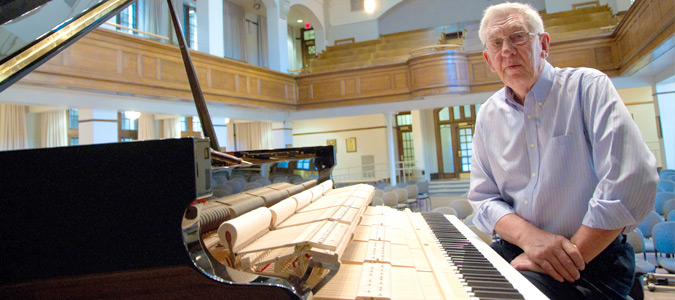Piano donation hits all the right notes for music students
Roger Jolly sits down on the piano bench and flips open a small bag next to him. Most of the pieces he will use to tune the piano look strange and unfamiliar, except for one he pulls out of his pocket—his iPhone. He puts it on the music stand and watches as sound waves float in and out of a circle like a heart monitor.
By Colleen MacPherson "This app is worth about $1,000," says Jolly, noting the confusion over an iPhone being used to tune one of the world's finest pianos. He says the app will help test the piano's frequencies and make it easier for him to tune the instrument perfectly for the room. It's the only piece of electronic equipment he uses.
"This app is worth about $1,000," says Jolly, noting the confusion over an iPhone being used to tune one of the world's finest pianos. He says the app will help test the piano's frequencies and make it easier for him to tune the instrument perfectly for the room. It's the only piece of electronic equipment he uses.
Jolly then grabs the entire keyboard with both hands and pulls it, hammers and all, out of the piano towards him. Now when he hits any of the 88 keys, he can see what the action of the hammers look like without hitting the strings.
"Can you see these two keys?" he asked, hitting a middle C and D simultaneously. "Notice how this key is jumping just a bit too high."
Jolly takes a small tool that looks like a dentist pick and makes a few slight adjustments to the hammer of the D string.
Jolly, a renowned piano technician and owner of the Yamaha Piano Centre locations in Saskatoon and Regina has, along with his wife Marie, donated one of the world's finest pianos to the University of Saskatchewan. Worth about $250,000 new, it was given because "students deserve to play one of the finest instruments in the world," said Jolly.
"I think our students need to know, feel, experience and hear what the very best is, so they know where to set their sights for performance levels."
The C. Bechstein D280, a 10-foot concert grand piano, is one of the 10 best pianos in the country, "and I bet it is now the nicest piano on a university campus in Canada," he added.
The instrument was moved into Convocation Hall earlier this fall and Jolly tuned it himself prior to its first performance on Sept. 30.
"The piano is so sensitive that it'll do whatever a pianist wants it to do, including play the wrong notes quite well,"
he joked.
Jolly continues to pull the keyboard in and out of the piano, testing each hammer and listening for irregularities in the sound each note makes.
"Can you hear this one? It sounds a bit chimey," he both asks and tells at the same time. "I need to dampen the hammer a bit so it sounds clearer."
Then, like a butcher tenderizing a piece of meat, Jolly jabs at the hammer's fabric with a small, sharp pick. "This dampens the sound a bit … and there, you can hear it now, it sounds much better."

